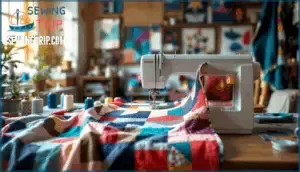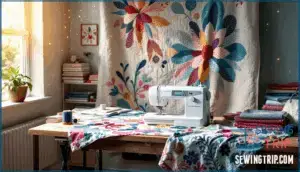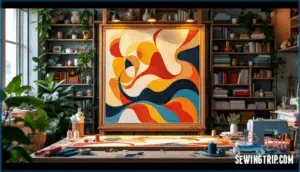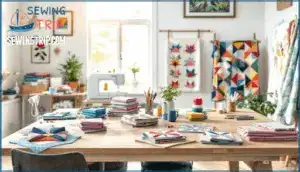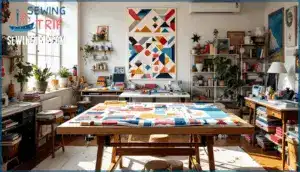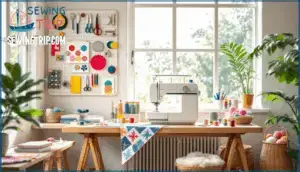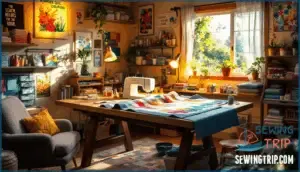This site is supported by our readers. We may earn a commission, at no cost to you, if you purchase through links.
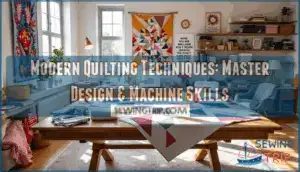 Modern quilting breaks the rules on purpose. While traditional quilting demands precision and symmetry, contemporary techniques embrace imperfection, negative space, and spontaneous design choices that feel completely alive on fabric.
Modern quilting breaks the rules on purpose. While traditional quilting demands precision and symmetry, contemporary techniques embrace imperfection, negative space, and spontaneous design choices that feel completely alive on fabric.
Your domestic sewing machine becomes a creative tool rather than just a precision instrument—you can stitch loose, winding lines instead of geometric patterns, build quilts in manageable sections as you go, and let asymmetrical layouts create visual tension that draws the eye.
Whether you’re drawn to minimalist grids, bold graphics, or free-motion improvisation, modern quilting techniques give you permission to experiment with scale, mix busy fabrics with quiet spaces, and develop a style that’s genuinely yours. Learning these methods opens up a completely different way of working, one where technique supports your vision instead of constraining it.
Table Of Contents
Key Takeaways
- Modern quilting intentionally breaks traditional rules by embracing imperfection, asymmetry, and negative space as powerful design elements rather than flaws to avoid.
- Negative space functions as your most critical design tool—the empty areas direct the viewer’s eye and create visual hierarchy, making your bold elements pop without overwhelming the composition.
- Machine quilting with a walking foot and free-motion techniques transforms your domestic sewing machine into a creative instrument where you control line quality, texture, and spontaneous design choices.
- Your personal style emerges when you stop following formulas and start experimenting with unconventional block scales, high-contrast color palettes, and strategic mixing of busy prints with calm spaces.
Core Design Principles of Modern Quilting
Modern quilting breaks free from rigid traditions, giving you room to make quilts that feel fresh and distinctly yours. The core design principles that guide this approach aren’t hard rules—they’re more like invitations to experiment and think differently about what a quilt can be.
Modern quilting breaks free from rigid traditions, inviting you to experiment and create quilts that feel fresh and distinctly yours
Let’s explore the foundational ideas that make modern quilts stand out.
Simplicity and Minimalism
Modern quilting strips away the noise, letting you focus on what actually matters—clean lines, breathing room, and designs that pack a punch without trying too hard. Think of minimalism as your creative permission slip. You’re not bound by busy prints or complicated piecing; instead, you’re working with simple shapes and calm colors that let your design breathe. This approach gives your work impact through restraint rather than excess.
- Clean lines and minimal fabrics create visual clarity—fewer elements mean each one counts
- Empty space becomes a design element itself, not something to fill
- Simple shapes allow asymmetry and improvisation to shine without visual chaos
Negative Space and Balance
Once you’ve mastered the art of restraint, it’s time to learn how negative space becomes your most powerful design tool—the white or empty areas on your quilt aren’t wasted real estate, they’re intentional breathing room that makes everything else pop. Think of it like framing: the empty spaces direct your eye exactly where you want it to go, creating visual hierarchy without fussiness.
When you embrace Negative Forms and practice Balance Theory, you’ll discover that less truly is more. Asymmetry gains power through spatial harmony—uneven placement feels intentional rather than accidental.
| Design Element | Effect | Application |
|---|---|---|
| Negative Space | Creates visual breathing room and focus | Frame pieced blocks with empty fabric |
| Asymmetrical Balance | Draws eye through vivid tension | Place bold shapes off-center purposefully |
| Spatial Harmony | Unifies scattered elements cohesively | Space blocks with varying distances |
| Empty Forms | Emphasizes positive shapes through contrast | Use solid backgrounds strategically |
| Visual Hierarchy | Guides viewer through composition naturally | Let negative space highlight focal points |
Your quilt’s empty spaces work harder than any seam. Don’t fear leaving areas quiet—that restraint is what makes modern quilts sing.
Modern Color Palettes and Contrast
Now here’s where color stops being timid and starts doing the heavy lifting—modern quilts use bold, unexpected palettes and high-contrast combinations that make your eye actually want to linger on the piece. Color theory becomes your playground, not a rulebook. You’re playing with saturation levels and hue selection to create tension and movement, letting negative space highlight what matters most.
Consider these avantgarde strategies:
- Tonal balance between bold, saturated colors and muted tones grounds your composition and prevents visual chaos.
- High contrast juxtapositions—think deep navy against bright chartreuse—command attention and energize the entire quilt.
- Modern color palettes that feel unexpected, sometimes clashing deliberately, give your work that contemporary edge.
The magic? You’re not playing it safe anymore. Your color choices are intentional statements.
Reinterpreting Traditional Blocks
That color confidence carries straight into how you rethink traditional blocks. Instead of recreating your grandmother’s Log Cabin or Flying Geese exactly, modern quilters enlarge, fragment, and rearrange these heritage patterns with radical freedom. You might blow up a single block to 200–400% of its original size, strip away the busy sashing that once defined it, and let negative space breathe around it. Think of block reconstruction as a conversation with the past—you’re honoring the lineage while speaking a completely contemporary language.
By exploring modern quilt blocks with modern quilting techniques, quilters can create unique and original designs.
| Technique | Classic Approach | Modern Reimagining |
|---|---|---|
| Scale | Uniform 4–8 inch blocks | Enlarged 12–32 inch statement pieces |
| Color | Patterned prints and scraps | Solid fabrics, high-contrast palettes |
| Layout | Symmetrical grids | Asymmetrical, off-grid placements |
| Negative Space | Minimal (under 10%) | Dominant (35–50% of surface) |
This heritage revival gives improvisational quilting room to flourish. You’re not bound by rigid geometry anymore—you can shift, rotate, and layer blocks until they feel right to you. Contemporary blocks become vehicles for your personal vision, blending traditional techniques reimagined with boldness that the original makers might never have imagined.
Essential Machine Quilting Techniques
Now that you understand the foundational design principles of modern quilting, it’s time to get hands-on with the techniques that bring those ideas to life on your machine.
Machine quilting is where modern quilts really shine—it’s where you move beyond traditional stitching and start exploring the creative possibilities that make your work uniquely yours.
Let’s walk through the essential techniques that’ll give you the control and confidence to quilt with intention.
Using a Walking Foot for Even Stitching
If you’ve ever noticed your fabric layers shifting mid-stitch, leaving you frustrated and reaching for the seam ripper, a walking foot is about to become your best friend in the quilting world. This attachment feeds fabric evenly from both top and bottom, preventing those aggravating puckers and wonky lines that derail your modern quilting projects.
Proper stitch regulation and tension control depend on mastering fabric guidance with your walking foot, while machine calibration guarantees your straight lines stay perfectly straight every time.
- Attach the walking foot securely, aligning it with your machine’s presser bar
- Test stitch regulation on scrap fabric before starting your quilt sandwich
- Maintain consistent fabric guidance by letting the foot do the work—don’t force layers
- Adjust tension control gradually if fabric bunches or loops appear
- Clean and calibrate your machine regularly for peak walking foot performance
Free-Motion and Improvisational Quilting
Free-motion quilting turns your machine into a paintbrush, giving you the freedom to stitch in any direction without the constraints of feed dogs or rigid patterns. Drop your feed dogs, switch to a darning foot, and let your instincts guide you—improvisational quilting thrives on spontaneity.
These modern stitching techniques create creative layers with organic swirls, geometric bursts, or abstract doodles that transform your quilt into a one-of-a-kind masterpiece, embracing true quilting freedom through machine quilting techniques and improvisation.
Creating Unique Lines and Shapes
Think of quilting lines as the brushstrokes that bring your flat canvas to life—every curve, echo, and zigzag adds depth and movement that can make your design pop or whisper, depending on where you let your needle wander.
Experiment with geometric patterns alongside organic curved lines, or try shape manipulation by stitching concentric circles around a central motif.
Improvisational stitching lets you layer straight lines with unexpected angles, creating texture that’s uniquely yours through bold machine quilting techniques.
Quilt-as-You-Go Method
The quilt-as-you-go method breaks your project into manageable sections—each one quilted and finished before you stitch them together—so you can skip wrestling with a bulky quilt sandwich on your machine. You’ll work with individual quilt blocks or sewing panels, layering and stitching each piece independently before joining them with creative seam treatments that hide the mechanics.
This technique transforms your modern quilting approach:
- Turn fabric scraps into stunning panels without overwhelming your workspace
- Experiment with different stitch patterns on each section for varied texture
- Control your quilting layers with precision, perfect for machine quilting beginners
- Build complex designs one block at a time, keeping the creative process fun and stress-free
Creative Design Elements and Experimentation
Once you’ve nailed the basics, it’s time to push beyond the traditional grid and experiment with design elements that make modern quilts stand out. The real fun begins when you start playing with layout, scale, fabric choices, and visual contrast.
Here’s where your quilts can truly reflect your personal vision and break free from convention.
Alternative Grid Layouts and Asymmetry
Breaking away from the traditional square grid isn’t just rebellious—it’s one of the fastest ways to give your quilts a contemporary edge. Try shifting blocks off center or creating angular designs that pull the eye in unexpected directions.
Asymmetrical layouts paired with negative space can transform familiar patterns into something completely fresh. Don’t worry about perfect balance—unbalanced compositions often feel the most vibrant and alive.
Manipulating Block Scale and Size
Playing with scale—whether you’re super-sizing a single block or scattering tiny pieced squares across your design—can add unexpected drama and visual punch to even the simplest patterns. Scale variations breathe life into modern quilt design by creating focal points and rhythm.
Here’s how to experiment with block proportion:
- Oversized blocks anchor asymmetric layouts and command attention
- Fragmented blocks break up predictable patterns with modular design elements
- Mix large and small scales within one quilt for striking contrast
- Try graduated sizing—blocks that shift incrementally across your composition
Don’t be afraid to push scale to extremes. Quilt design principles are guidelines, not boundaries.
Bold Graphics and Contemporary Fabrics
Geometric prints and stripes are stealing the spotlight in modern quilt design, with high-contrast shapes and large-scale motifs dominating national shows throughout 2025. Cotton remains king—accounting for about 43% of material use—but contemporary fabrics like digital prints and eco-friendly textiles are reshaping what’s possible when you pair bold colors with striking negative space. The use of modern quilt patterns is becoming increasingly popular in the quilting industry.
| Fabric Type | Visual Impact | Best Use |
|---|---|---|
| Geometric prints | Sharp graphic areas | Focal blocks |
| Solid bold colors | Clean modern color palette | Negative space |
| Digital fabrics | Complex quilt innovation | Statement pieces |
Your fabric choices set the tone for modern quilt design—mix saturated hues with neutrals to let your graphic areas breathe, and don’t shy away from modern textiles that push traditional boundaries.
Mixing Busy and Quiet Elements
Now here’s where the magic happens—pairing those bold prints with plenty of breathing room on your quilt creates a rhythm that actually keeps people’s eyes moving instead of exhausted from visual overload. Think of it like a conversation: you need quiet moments between the big ideas to let them land. When you balance busy fabrics with solid negative space, you’re creating visual balance that feels intentional rather than chaotic. This interplay of pattern mixing and simplicity and minimalism is what separates modern quilts from feeling overwhelming.
Here’s how to nail this elemental flow:
- Anchor busy focal blocks with solid borders or sashing in your modern color palette to give them room to breathe
- Alternate patterned and plain sections so texture contrast emerges naturally, avoiding visual fatigue
- Use asymmetry strategically—offset your busiest elements against calm areas for vibrant tension without chaos
- Let negative space do the heavy lifting by treating it as an active design choice, not leftover real estate
Tools, Materials, and Technical Setup
Getting your setup right makes all the difference when you’re ready to start quilting on a domestic machine. Having the right tools and materials in your corner sets you up for success.
Whether you’re working with basic equipment or investing in newer technology, let’s walk through what you’ll need to know about machines, attachments, software, and fabrics to bring your modern quilting vision to life.
Domestic Machine Requirements
Your domestic sewing machine is more capable than you might think—with the right setup, it’s absolutely ready to manage everything modern quilting demands.
Start with machine maintenance to keep everything running smoothly, then dial in your tension control and stitch regulation for consistent results.
Thread selection matters more than most quilters realize; quality thread prevents frustration during machine quilting. Proper bobbin management and a walking foot transform your machine’s potential, letting you tackle free motion quilting and intricate designs with confidence.
It’s not about having the fanciest equipment—it’s about understanding what you’ve got.
Essential Quilting Attachments and Accessories
Once you’ve got your machine dialed in, the right attachments are what actually release its potential—and a walking foot is where most quilters should start. This attachment keeps your fabric layers moving evenly, preventing puckering when you’re stitching those straight lines.
Pair it with quality quilting needles and specialized thread types designed for machine quilting, and you’re ready to go. Add quilter gloves for better fabric control during free-motion work, and a sewing table extension to support larger projects.
These quilting tools transform how your machine performs, making the difference between frustrating sessions and confident, creative quilting.
Digital Patterns and Quilting Software
The real revolution in modern quilting isn’t just what you sew—it’s having a blueprint that matches your vision before you even thread the needle. Digital design tools have transformed how you approach pattern making, letting you experiment endlessly without wasting fabric or time.
Modern quilting software lets you visualize your quilt design principles before committing to cuts. Here’s what these tools bring to your workflow:
- Pattern customization – Adjust block sizes, layouts, and color schemes instantly to match your modern quilt design vision
- Instant access – Download quilting apps and digital patterns anytime, eliminating trips to shops and enabling efficient project planning
- Virtual quilting exploration – Test asymmetrical grids and design elements digitally before physically constructing
- Design element manipulation – Experiment with negative space and alternative layouts without permanent consequences
- Collaborative possibilities – Share digital files with other quilters, strengthening virtual quilting communities and modern quilting techniques knowledge
Whether you’re reinterpreting traditional blocks or pushing minimalist boundaries, quilting software removes guesswork and accelerates your creative process.
Fabric Selection for Modern Aesthetics
Fabric is where your modern quilt either sings or stumbles, so choosing it thoughtfully is just as important as nailing your design. Modern color palettes thrive on contrast and intention. Solid fabrics anchor your negative space, while bold prints add contemporary energy. The trick? Mix print scales strategically—pair small geometric prints with larger graphic designs. This creates visual rhythm without chaos. Batting options matter too; lighter weights suit minimalist designs, while thicker battings add dimension to pieced work.
| Element | Modern Application |
|---|---|
| Solid Fabrics | Define negative space and balance busy prints |
| Print Mixing | Layer small and large-scale graphics for depth |
| Color Theory | Use high contrast to emphasize modern design intent |
| Fabric Textures | Add dimension through woven or novelty materials |
| Batting Options | Light weights for minimalism, thick for dimensional quilts |
Think of fabric selection as color theory in action—every choice either reinforces or distracts from your design vision.
Getting Started and Finding Inspiration
Now that you’ve got the fundamentals down, it’s time to find your voice and connect with the creative community that’s making modern quilting what it’s today.
Whether you’re looking to learn from established quilters, join a collaborative project, or carve out your own style, there are plenty of pathways to grow.
Here’s where to find inspiration and take your practice forward.
Learning From Contemporary Quilters
Learning from contemporary quilters creates opportunities for cutting-edge design and technique. Over 61% of quilters rely on YouTube for inspiration, while online courses have surged 42% since 2020—making expert guidance more accessible than ever. Leading quilters like Julius Arthur offer structured online lessons emphasizing experimentation with shape, color, and negative space.
Tap into quilter communities through social platforms, explore modern quilting apps, and seek out workshops that challenge traditional rules. Their emphasis on flexibility and individual expression transforms how you approach modern quilt design and creative quilting techniques.
- YouTube tutorials and online workshops connect you with contemporary quilting aesthetics
- Structured courses teach improvisation and modern trends in quilting movement
- Digital communities foster peer learning and design inspiration sharing
Collaborative Projects and Quilt-Alongs
When you join a quilt-along or collaborate on a group project, you’re tapping into something that transforms quilting from a solo practice into a shared creative movement. Virtual workshops and online quilt-alongs connect you with quilters worldwide, sparking fresh ideas through real-time community engagement.
Charity quilts magnify your impact—turning stitches into purpose. Quilt challenges push your boundaries, while quilting community resources provide patterns, feedback, and encouragement.
These group endeavors aren’t just about finishing projects; they’re about belonging to something bigger, where inspiration flows freely and your voice matters.
Developing Your Personal Modern Style
At some point, all those techniques and principles you’ve learned start clicking together, and suddenly you’re not just following someone else’s vision—you’re building your own. That’s where creative freedom kicks in.
Stop worrying about doing it "right" and start experimenting with what feels true to you. Your personal expression matters more than flawlessness. Play with simplicity and minimalism, then break those rules with bold color palettes and improvisation.
Let your quilt artistry evolve naturally—mix busy prints with quiet spaces, scale blocks unexpectedly, reinterpret traditional patterns in modern ways. Style evolution happens when you trust your instincts and keep pushing boundaries.
Frequently Asked Questions (FAQs)
How do I bind and finish the edges of modern quilts?
Binding secures your quilt edges with durability and style. Cut strips (usually 25”), sew them to the front using a quarter-inch seam, then fold to the back and hand-stitch for a polished finish.
Modern quilts benefit from single-fold or double-fold bindings that emphasize clean lines and contemporary aesthetics.
How do I choose batting for different modern quilting styles?
Batting choice shapes your quilt’s personality as much as fabric does. Cotton batting works beautifully for minimalist modern quilts, offering crisp definition and minimal loft. Polyester batting provides more bounce, ideal when you’re layering busy prints or experimenting with maximalist designs.
Low-loft options accentuate negative space and clean lines; high-loft creates dimension for dimensional modern pieces. Match your fiber choice to your design vision and quilting technique.
Should I use a longarm quilter or quilt at home?
Your choice depends on your priorities. Home quilting with a walking foot offers cost savings and creative control—perfect for modern designs requiring experimentation.
Longarm quilters provide time savings and professional results for larger projects, but at higher cost.
Consider your budget, project volume, and desired design complexity when deciding which quilting method suits your style.
How do I prevent puckering when machine quilting?
It’s ironic—the more perfectly you prepare, the less likely puckering appears. Start with proper fabric prep: prewash and press everything flat.
Your walking foot keeps layers moving evenly, but tension control is equally critical. Thread choice matters; use quality thread matching your fabric weight.
Select appropriate batting for your project, and engage stitch regulation on computerized machines. These quilting techniques work together, preventing puckering along your quilting lines and straight lines alike.
Conclusion
Modern quilting techniques aren’t about perfecting someone else’s vision—they’re about discovering your own voice on fabric. Like a musician learning scales, you master the fundamentals of walking feet, free-motion stitching, and intentional negative space not to copy tradition, but to break free from it.
Every stitch becomes a choice, every asymmetrical line a declaration. Your modern quilting techniques evolve as you experiment, fail, and create again. The machine becomes an extension of your hand. Start stitching, stay curious, and let your quilts become unmistakably yours.
- https://mrsquilty.com/blogs/news/quilting-industry-trends-in-usa-statistics-and-insights
- https://www.verifiedmarketreports.com/product/computerized-quilting-machines-market/
- https://quiltlizzyayden.com/blogs/quilt-lizzy-ayden-blog/top-quilting-trends-to-watch-in-2025
- https://suzyquilts.com/what-quilters-want-in-2023/
- https://dataintelo.com/report/industrial-quilting-machine-market

